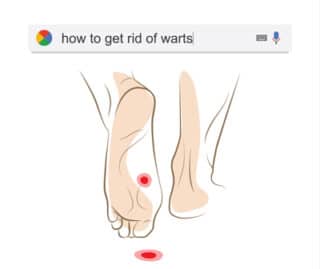
Arlington Podiatry Center
611 South Carlin Springs Road
Suite #512
Arlington, VA 22204

More Podiatry Foot Care Articles
Plantar Warts – Warts on the Bottom of Your Feet

Warts are an infection caused by a virus which invades your skin through a cut or break. An individual who has a wart can develop additional warts. Plantar warts are often mistaken for corns or calluses on the sole of the foot. Plantar warts have a spongy appearance with little black, brown or red spots. These spots are the blood vessels feeding them.
They are found usually on the bottom of the foot, but can appear on the toes. The warts are circumscribed, which means you may notice a light ring around each growth separating it from the surrounding skin. Warts can occur alone (solitary) or with smaller warts clustered nearby (mosaic).
There are many different ways to remove warts. Each method has its own advantage and disadvantage. Medication or surgical removal, or both, are usually the most effective treatments. Freezing or burning may also be utilized. A podiatrist can combine any of these methods with others to tailor a treatment option best suited to the patients condition.
Chemical cauterization is the use of relatively strong acids and caustics to destroy the wart tissue. The wart is usually not destroyed completely in one treatment. Usually a series of treatments, which may extend over a period of 8 – 10 weeks is needed. However, there is little post-operative care needed once the wart is removed.
Surgical options include using a surgical curette to scoop or shell out each individual wart. This method is usually used in conjunction with electrodesiccation, or electrical cauterization. This method helps discourage re-growth.
The other surgical option is to make two small semielliptical incisions surrounding the wart. Then the wart and the surrounding skin are removed. The edges of the skin are then brought together with stitches. These surgical options are usually done under a local anesthetic. The post operative consideration for surgical removal is that the patient will want to try to remain non-weight bearing on the foot for approximately one week. Also, daily dressing changes will need to be done to prevent infection.
Laser surgery and cryosurgery are two other methods of removal. When utilizing a laser the wart is vaporized using focused high frequency light. Cryosurgery is the use of intense cold to destroy the lesion. Liquid nitrogen and carbon dioxide are most commonly used to freeze the tissue.
After laser surgery the patient can ambulate normally immediately. However, after the cryosurgery a painful blister may develop which is removed in approximately 10-14 days.
After your podiatrist treats your warts, protect your feet from future infection by keeping them clean and dry. Avoid going barefoot in public places like showers, gyms and locker rooms. The wart virus may spread easily in moist settings like these. Wear thongs or sandals on your feet.
If you’re considering using over-the-counter medications for warts, ask your podiatrist first. Some of these treatments can damage skin and may be dangerous if you have diabetes or poor circulation.

















